Eduard 1/48 Dassault Mirage IIICJ “Profipack”
This model was done 10 years ago when the kit first came out. It's still the best 1/48 Mirage kit and well worth having, particularly in the Profipack release.
Like the Spitfire and the Battle of Britain, the P-51 and the daylight battles over Germany, and the F-86 over MiG Alley, the Mirage III is indelibly connected to the Six Day War.
It is generally considered that Egypt initiated the crisis leading to the 1967 war by taking actions in April 1967 which forced the Israelis to plan a preventive war to avoid destruction. In the view of many Middle East specialists, Israel may have instigated the crisis by fooling the intelligence agencies of the Soviet Union with a disinformation campaign regarding Israeli military intentions. Soviet diplomats in turn led both Syria and Egypt to believe that Israel was massing troops to attack Syria, prompting Nasser to begin preparations to come to Syria's aid. President Nasser obviously overreacted in the spring of 1967 by asking that the United Nations forces in the Sinai Peninsula separating Egyptian and Israeli troops be withdrawn. This suddenly put Egyptian forces back in control of the Strait of Tiran, at the mouth of the Gulf of Aqaba, which Nasser then declared closed to Israeli shipping, a move unacceptable to Israel. It also was unacceptable to the U.S., which had secretly guaranteed - when it forced Israel to withdraw from the Sinai in 1956 - that the strait would remain open.
Nasser's "mindset" at the time may have influenced his actions. This was that the United States was “out to get him." Looking back at the events of 1965 and 1966, Nasser's conclusion is understandable. U.S. wheat deliveries had been withheld; re‑scheduling of Egypt's debts was delayed; U.S.‑promised grain silos went unbuilt, and then‑Secretary of State Dean Rusk did not make a promised visit to Cairo. Nasser's own fiery rhetorical attacks on U.S. Middle East policies further weakened his cause in the United States.
Whoever was ultimately responsible for the outbreak of war, most observers agree that the Six Day War in 1967 marked the end of Nasser's Pan‑Arab dream. The rivalry and distrust between President Nasser and his unrealistic military commander, Marshall Abdul Hakim Al‑Amr, played a big role, with Amr thinking that the Egyptian armed forces could defeat Israel.
By June 1967, the Arab‑Israeli situation had deteriorated to the point of no return. After the UN peacekeeping force in the Sinai peninsula had been withdrawn at Nasser's request, and Egyptian guns blockaded the Gulf of Aqaba to Israeli ships, denying their access to the port of Eilat, Israel attacked Egypt and in six days of combat occupied the entire Sinai Peninsula up to the Suez Canal.
President Nasser had left his air force totally unprotected on the ground from possible Israeli air attacks, while engaged in verbal threats and menacing maneuvers against Israel. The Israelis, on the other hand, had been planning such a blow for five years, believing war to be inevitable with the only question being when it would break out.
On the first day of the war, June 5, 1967, the IDF/AF staged what has come to be considered the most successful strategic air attack ever delivered. At 0710, Israeli time, 16 armed Fouga Magisters took off from Hatzor, transmitting on frequencies used by Super Mystere and Mirage jets, and flew a routine patrol pattern at standard altitude.
At 0714, Dassault Ouragan and Mystere fighter-bombers left Hatzor, followed five minutes later by the Mirages of 119 Squadron at Ramat David, with another 15 Vautours from Hatzerim. These aircraft headed west into the Mediterranean at wave-top height, their targets the air bases of Faid and Kibrit. By 0730, a total of 200 aircraft were airborne. The aircraft flew at no more than 15 meters above the Sinai desert and the Red Sea as they headed into Egyptian airspace. While the Super Mystere, Mystere, Ouragan and Vautour aircraft were armed with bombs and rocket packs, the Mirages were ready for air-to-air combat, carrying supersonic fuel tanks and their gun armament only. Strict radio silence was observed, with only hand-signals used between aircraft.
Virtually no one inside Israel outside of the Air Force planning staff knew more than a bare outline of the plans for Operation Focus. Israeli intelligence was so good they knew the location of every airplane in the Egyptian Air Force and even the name of the assigned pilot; much of this had been gained by Wolfgang Lotz, a German-born Israeli spy who had posed as a former SS officer in order to gain vital details from the Egyptian military leaders he befriended prior to his capture in 1964. Other high-placed spies included Ali al-Alfi - Nasser's personal masseur - and provided what Air Force Commander Matti Hod later called “Israel's real-time intelligence.”
The Egyptians had set themselves up for such an attack; each aircraft type was concentrated at its own base, allowing the Israelis to prioritize their targets. Proposals for constructing bomb-proof concrete hangars had been submitted by the air force, but none had been built. Assuming any Israeli attack would come at dawn, the MiGs had already flown their patrols and returned to base at about the same time the first elements of the attacking forces took off. The Egyptians believed the main air bases of Faid and Kibrit were out of range to Israeli aircraft, and jets were parked on the aprons in rows; they were wrong. Many airfields had only one runway; if the Israelis blocked it, no further operations could take place.
The Egyptians had one chance to discover what was coming. The Jordanian radar facility at Ajlun was one of the most sophisticated in the entire middle east. The screens were suddenly inundated with blips at 0715. The officer in charge radioed in the prearranged code for war to headquarters in Amman, from whence it was relayed to the Egyptian Defense Ministry - where it sat, indecipherable. The Egyptians had changed their codes on June 4, failing to notify the Jordanians. The Jordanians watched the Israeli aircraft head into the Sinai, repeatedly sending the indecipherable warning.
The Israeli plan, which required all aircraft to rendezvous over eleven targets between 45 and 20 minutes' flying time from their bases, was exceedingly hazardous. All but 12 air force jets were involved. Training for the attack had reduced turnaround time for the second and third wave attacks to less than 8 minutes per aircraft. Operation Focus was what is called in American football a “Hail Mary” pass.
As the Israelis bored in, the skies over Egypt were cloud-free, with wind factor at most bases close to zero. At the last moment, the Israelis swooped upwards as high as 9,000 feet, suddenly appearing on Egyptian air defense radars as they rolled in on their attacks. Each airplane made three passes - the first for bombing and the next two for strafing. Priority was given to destroying the runways using Durandal bombs, then destroying the long-range bombers that threatened Israeli cities. Each attack took eight minutes, with a maximum 20 minute return flight; with an 8 minute turnaround, this meant the next wave of attacks would be back over Egypt within an hour, and the raids were scheduled so that Egyptian airspace was saturated during that time.
The attacks were carried out with such ferocity that when one Tu-16 at Luxor blew up, the attacking Israeli jet was literally blown out of the sky by the 10-ton explosion. By the end of the first wave attack, the Egyptians had lost 190 aircraft - nearly half their air force - and the main communications between Cairo and the army in Sinai had been severed.
The Israelis themselves were stunned by their success, with kill ratios exceeding estimates by 100 percent. They had expected losses of 25-30 percent, but instead lost 8 aircraft and 5 pilots. Indeed, Israeli HQ refused to believe the initial reports until Hod had conducted personal debriefings with mission leaders. During the 100 minutes following the first strikes, 164 further sorties were flown, destroying another 107 aircraft for 9 losses.
Of 420 aircraft in the Egyptian Air Force that morning, 286 were destroyed, along with the loss of nearly one-third of their crews. Thirteen bases were rendered inoperable, along with 23 radar stations and AAA sites. At 1035, Hod turned to Moshe Dayan and reported “The Egyptian Air Force has ceased to exist.”
As Egyptian General Zaki put it: “Israel spent years preparing for this war, whereas we prepared for parades. The drills for the annual Revolution Day parade went on for weeks, while there were no preparations for war.”
During the remaining five days of combat, Mirages would shoot down nearly all Egyptian, Syrian and Jordanian aircraft which managed to get airborne. In the War of Attrition that would follow and then in the Yom Kippur War of 1973, more aces would fly the Mirage III than any fighter since the F-86 Sabre.
The Six Day War is the event which created the contemporary Middle East. An Israeli friend of mine - who participated in the battle of Jerusalem - recalls that when he stood at the Wailing Wall for the first time, his prayer was “God help us, we've won.”
Forty-seven years later, the shock waves of the Six Day War still rattle governments around the world.
Eduard's Mirage is the best kit of this famous fighter in any scale: dimensions, shape, production quality, it is heads above any others. The kit is easy to assemble, and the Profipack version gives a lot of detail for the cockpit and the rest of the airframe. Excellent decals are provided for 2 Israeli silver '67 war Mirages, two camouflaged airplanes from the Yom Kippur War along with three silver French Mirages and two camouflaged airplanes.
I used several SNJ metal enamel shades for the paint scheme.
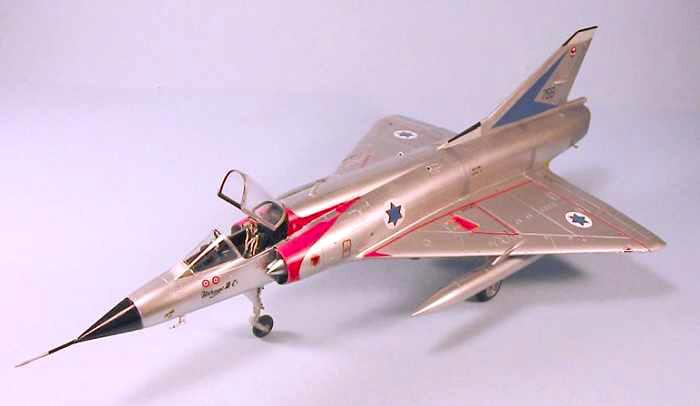
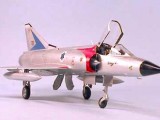
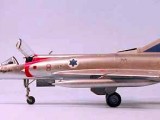
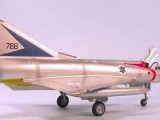
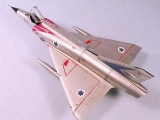
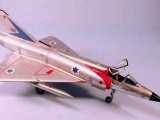
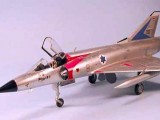
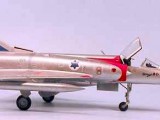
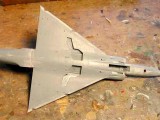
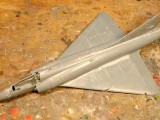
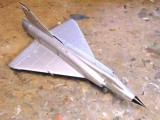
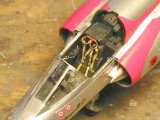
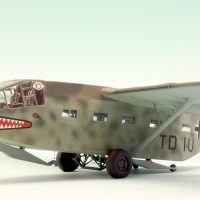
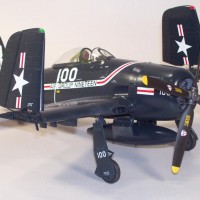
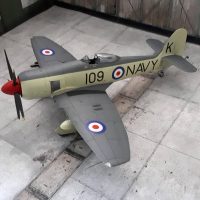

Very thourough account of the 6-Day air war & a great looking Mirage.
Thanks
Thanks for cool little synopsis of the "Hail Mary". Have had that kit in my stash since it first came out, the one and only jet kit I own. Love the Silver scheme, gotta build it sometime.
A thrilling story for my breakfast, thank you ! And a very nice Mirage
as well !
Bernd
Great model of a classic fighter. Yeah amazing operation, always admired the Israelis fighting spirit, especially after what the went through in the war. I remember reading the 67 war changed the thinking on putting guns on fighters, as till then it was though air combat would be a missile war. But I think more then half the Israeli combat kills were gun kills, after which fighters were always designed with gun installations.
Like Bernd said, a great story for this Saturday morning as well as the model itself. Now I have an itch to build one myself.
1967 kills were almost cannon-only while 1973 was the opposite for the IAF. The bad results for the US in Vietnam using missiles were not only due to faulty missiles, a large part came from strict ROE that prohibited the pilots from using the strengths of the missiles.
A very nice Mirage Tom, that is not the easiest scheme to depict well even if it looks simple. I have a few Mirages in 1/72 but will probably go for a camo bird. Whenever I get around to it...
Regards Magnus
Gotta love the IAF, with some of the best performing jets and some of the finest fighter pilots in the world...protecting this tiny country, completely surrounded by enemies. The Mirage...how can one really dig jets and not put this a/c among the best looking on the planet. And your model has done it proud.
Really nice colors for the delta french figther !
thanks you !
Nice clean build and great narrative.
Tom,
Very nicely done and again a good story..